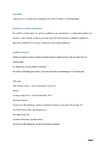Remimazolam; a role for anaesthesia/ sedation?
| dc.contributor.author | Sneyd, John | |
| dc.contributor.author | Rigby-Jones, A | |
| dc.date.accessioned | 2020-05-18T13:24:28Z | |
| dc.date.issued | 2020-08 | |
| dc.identifier.issn | 0952-7907 | |
| dc.identifier.issn | 1473-6500 | |
| dc.identifier.uri | http://hdl.handle.net/10026.1/15687 | |
| dc.description.abstract |
<jats:sec> <jats:title>Purpose of review</jats:title> <jats:p>Anaesthesia and sedation are ubiquitous in contemporary medical practice. Developments in anaesthetic pharmacology are targeted on reducing physiological disturbance whilst maintaining or improving titrateability, recovery profile and patient experience. Remimazolam is a new short-acting benzodiazepine in the final stages of clinical development.</jats:p> </jats:sec> <jats:sec> <jats:title>Recent findings</jats:title> <jats:p>Clinical experience with remimazolam comprises volunteer studies and a limited number of clinical investigations. In addition, laboratory investigations explore the implications of its ‘soft drug’ pharmacology.</jats:p> </jats:sec> <jats:sec> <jats:title>Summary</jats:title> <jats:p>Remimazolam provides effective procedural sedation with superior success rates and recovery profile when compared to midazolam. Comparisons with propofol are required. Preliminary studies suggest potential for using remimazolam as the hypnotic component of general anaesthesia. Definitive studies are awaited. As a benzodiazepine, remimazolam could be evaluated as an anticonvulsant and for intensive care sedation.</jats:p> </jats:sec> | |
| dc.format.extent | 506-511 | |
| dc.format.medium | ||
| dc.language | en | |
| dc.language.iso | en | |
| dc.publisher | Lippincott, Williams & Wilkins | |
| dc.subject | anaesthesia | |
| dc.subject | midazolam | |
| dc.subject | propofol | |
| dc.subject | remimazolam | |
| dc.subject | sedation | |
| dc.title | Remimazolam; a role for anaesthesia/ sedation? | |
| dc.type | journal-article | |
| dc.type | Journal Article | |
| dc.type | Review | |
| plymouth.author-url | https://www.webofscience.com/api/gateway?GWVersion=2&SrcApp=PARTNER_APP&SrcAuth=LinksAMR&KeyUT=WOS:000549913800005&DestLinkType=FullRecord&DestApp=ALL_WOS&UsrCustomerID=11bb513d99f797142bcfeffcc58ea008 | |
| plymouth.issue | 4 | |
| plymouth.volume | 33 | |
| plymouth.publication-status | Published | |
| plymouth.journal | Current Opinion in Anaesthesiology | |
| dc.identifier.doi | 10.1097/ACO.0000000000000877 | |
| plymouth.organisational-group | /Plymouth | |
| plymouth.organisational-group | /Plymouth/Faculty of Health | |
| plymouth.organisational-group | /Plymouth/Faculty of Health/Peninsula Medical School | |
| plymouth.organisational-group | /Plymouth/Research Groups | |
| plymouth.organisational-group | /Plymouth/Research Groups/Plymouth Institute of Health and Care Research (PIHR) | |
| plymouth.organisational-group | /Plymouth/Users by role | |
| plymouth.organisational-group | /Plymouth/Users by role/Academics | |
| dc.publisher.place | United States | |
| dcterms.dateAccepted | 2020-05-01 | |
| dc.rights.embargodate | 2021-6-8 | |
| dc.identifier.eissn | 1473-6500 | |
| dc.rights.embargoperiod | Not known | |
| rioxxterms.versionofrecord | 10.1097/ACO.0000000000000877 | |
| rioxxterms.licenseref.uri | http://www.rioxx.net/licenses/all-rights-reserved | |
| rioxxterms.licenseref.startdate | 2020-08 | |
| rioxxterms.type | Journal Article/Review |


